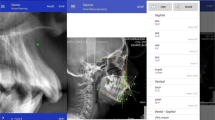Abstract
Cephalometric analyses of lateral cephalograms allow important statements to be made on diagnosis and treatment planning. Such radiographs should, however, be taken with a considerable reduction in radiation exposure. With the Digigraph® 100 (Dolphin Imaging Systems Inc., USA) a cephalometric technique based on distance measurements of emitted sonic signals is now available. This study was aimed at determining the degree to which this procedure can cope with the requirements of reliability and validity in the field of orthodontics.
For this purpose 50 volunteers were examined by conventional cephalometry with manual tracing of lateral cephalograms as well as by sonic cephalometry, with Jarabak analysis in both cases. In addition an option was available for reading lateral cephalograms into the Digigraph® by means of a radiography evaluation program. The 31 evaluated parameters were subjected to modified statistical analysis.
Good reliability was recorded in the range between 0.96 and 0.99 for eleven sonic cephalometric measurements, whereas 26 values were between 0.69 and 0.95. The validity was significantly lower in comparison to radiocephalometry. In particular, measurements related to landmarks which were difficult to access or could be only indirectly determined, such as the sella point, the articulare point or the apices of the incisors, proved to be weak points of sonic cephalometry.
The device is thus indicated rather in the field of communication with the patient or for intermediate examination without radiation exposure. Cephalometry without radiation exposure would represent decisive progress in orthodontic diagnostics. However, some developmental work on the processing software or even the development of a specific sonic cephalometry which deliberately dispenses with parameters that are difficult to record with this procedure is still needed.
Zusammenfassung
Die kephalometrische Analyse eines Fernröntgenseitenbildes erlaubt es, für die Diagnostik und Planung einer Behandlung wichtige Aussagen zu machen. Die Anfertigung einer solchen Röntgenaufnahme sollte jedoch unter weitestgehender Reduktion der Strahlenexposition geschehen. Mit dem Digigraph® 100 (Dolphin Imgaing Systems, USA) steht nun eine auf der Distanzmessung emittierter Schallsignale basierende Kephalometrietechnik zur Verfügung. Ziel dieser Studie war es herauszufinden, inwieweit das Verfahren den Anforderungen an Reliabilität und Validität auf dem Gebiet der Kieferorthopädie zu genügen vermag.
Hierzu wurden 50 Probanden konventionell kephalometrisch unter manueller Durchzeichnung der Fernröntgenseitenbilder sowie schallkephalometrisch jeweils nach der Analyse von Jarabak untersucht. Zusätzlich bestand die Option, die Fernröntgenseitenbildaufnahmen mit Hilfe eines Röntgenauswerteprogramms in den Digigraph® einlesen zu lassen. Die 31 ermittelten Parameter wurden einer modifizierten statistischen Analyse zugeführt.
Es ergab sich eine gute Reliabilität im Bereich 0,96 bis 0,99 für elf schallkephalometrische Messungen, während 26 Werte zwischen 0,69 und 0,95 lagen. Die Validität im Vergleich zur Röntgenkephalometrie lag deutlich niedriger. Insbesondere erwiesen sich Maße, die sich auf nur indirekt zu bestimmende oder schwer zugängliche Messpunkte wie den Sellapunkt, den Artikularepunkt oder auch die Zahnwurzelspitzen der Inzisivi beziehen, als Schwachstellen der Schallkephalometrie.
Die Indikation des Gerätes ist daher eher im Bereich der Kommunikation mit dem Patienten oder für Zwischenuntersuchungen ohne Strahlenexposition zu sehen. Eine Kephalometrie ohne Strahlenexposition wäre ein entscheidender Fortschritt für die kieferorthopädische Diagnostik. Allerdings bedarf es hierzu noch einiger Entwicklungsarbeit bei der Verarbeitungssoftware oder gar der Entwicklung einer eigenen Schallkephalometrie, die bewusst auf die Einbeziehung mit diesem Verfahren schwierig zu erfassender Parameter verzichtet.
Similar content being viewed by others
Author information
Authors and Affiliations
Additional information
Received: May 5, 2000; accepted: September 19, 2000
Rights and permissions
About this article
Cite this article
Doll, G., Zentner, A., Krummenauer, F. et al. Reliability and Validity of the Digigraph® 100 in Orthodontic Diagnosis. Journal of Orofacial Orthopedics / Fortschritte der Kieferorthopädie 62, 116–132 (2001). https://doi.org/10.1007/s00056-001-0028-7
Issue Date:
DOI: https://doi.org/10.1007/s00056-001-0028-7




